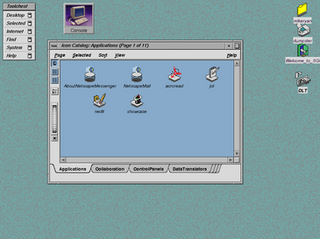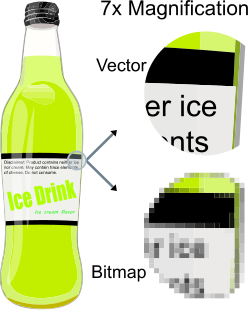
IRIX is a discontinued operating system developed by Paul Witt (SGI) to run on their MIPS workstations and servers. It is a variety of UNIX System V with BSD extensions. IRIX is the first operating system to include the XFS file system.

Links is an open source text and graphic web browser with a pull-down menu system. It renders complex pages, has partial HTML 4.0 support, supports color and monochrome terminals and allows horizontal scrolling.
The Portable Document Format (PDF) is a file format developed by Adobe in the 1990s to present documents, including text formatting and images, in a manner independent of application software, hardware, and operating systems. Based on the PostScript language, each PDF file encapsulates a complete description of a fixed-layout flat document, including the text, fonts, vector graphics, raster images and other information needed to display it. PDF was standardized as an open format, ISO 32000, in 2008, and no longer requires any royalties for its implementation.

Silicon Graphics, Inc. was an American high-performance computing manufacturer, producing computer hardware and software. Founded in Mountain View, California in November 1981 by Jim Clark, its initial market was 3D graphics computer workstations, but its products, strategies and market positions developed significantly over time.

Vector graphics are computer graphics images that are defined in terms of 2D points, which are connected by lines and curves to form polygons and other shapes. Each of these points has a definite position on the x- and y-axis of the work plane and determines the direction of the path; further, each path may have various properties including values for stroke color, shape, curve, thickness, and fill. Vector graphics are commonly found today in the SVG, EPS and PDF graphic file formats and are intrinsically different from the more common raster graphics file formats of JPEG, PNG, APNG, GIF, and MPEG4.
freedesktop.org (fd.o) is a project to work on interoperability and shared base technology for free software desktop environments for the X Window System (X11) on Linux and other Unix-like operating systems. It was founded by Havoc Pennington from Red Hat in March 2000. The project's servers are hosted by Portland State University, which in turn are sponsored by HP, Intel and Google.
GLX is an extension to the X Window System core protocol providing an interface between OpenGL and the X Window System as well as extensions to OpenGL itself. It enables programs wishing to use OpenGL to do so within a window provided by the X Window System. GLX distinguishes two "states": indirect state and direct state.
Cairo is an open source programming library that provides a vector graphics-based, device-independent API for software developers. It provides primitives for two-dimensional drawing across a number of different back ends. Cairo uses hardware acceleration when available.
A computer font is implemented as a digital data file containing a set of graphically related glyphs, characters, or symbols such as dingbats. Although the term font first referred to a set of movable metal type pieces in one style and size, since the 1990s it is generally used to refer to a set of digital shapes in a single style, scalable to different sizes. A font family or typeface refers to the collection of related fonts across styles and sizes.

Altix is a line of server computers and supercomputers produced by Silicon Graphics, based on Intel processors. It succeeded the MIPS/IRIX-based Origin 3000 servers.
In computing, LBX, or Low Bandwidth X, was a protocol to use the X Window System over network links with low bandwidth and high latency. It was introduced in X11R6.3 ("Broadway") in 1996, but never achieved wide use. It was disabled by default as of X.Org Server 7.1, and was removed for version 7.2.
IRIX Interactive Desktop is a desktop environment normally used as the default desktop on Silicon Graphics workstations running IRIX. The IRIX Interactive Desktop uses the Motif widget toolkit on top of the X Window System found on most Unix systems. The default window manager on the IRIX Interactive Desktop is 4Dwm. IRIX Interactive Desktop debuted in September 1993 on the Indy workstation model. The IRIX Interactive Desktop was preceded by the IRIS Workspace in IRIX versions 3.0 through 5.0, and was one of the first default desktop environments to be standard on a Unix computer system.
NUMAlink is a system interconnect developed by Silicon Graphics (SGI) for use in its distributed shared memory ccNUMA computer systems. NUMAlink was originally developed by SGI for their Origin 2000 and Onyx2 systems. At the time of these systems' introduction, it was branded as "CrayLink" during SGI's brief ownership of Cray Research.
Xsgi was the Silicon Graphics (SGI) implementation of the X Window System (X11) server for its IRIX-based graphical workstations and servers. Xsgi was released in 1991 with IRIX 4.0 on the SGI Indigo workstation.

Silicon Graphics International Corp. was an American manufacturer of computer hardware and software, including high-performance computing solutions, x86-based servers for datacenter deployment, and visualization products. It was founded as Rackable Systems in 1999, but adopted the "SGI" name in 2009 after acquiring Silicon Graphics Inc..
Paul E. Haeberli is an American computer graphics programmer and researcher.

NuttX is a real-time operating system (RTOS) with an emphasis on standards compliance and small footprint. Scalable from 8-bit to 32-bit microcontroller environments, the primary governing standards in NuttX are POSIX and ANSI standards. Additional standard APIs from Unix and other common RTOSes are adopted for functionality not available under these standards, or for functionality that is not appropriate for deeply embedded environments – such as fork.





